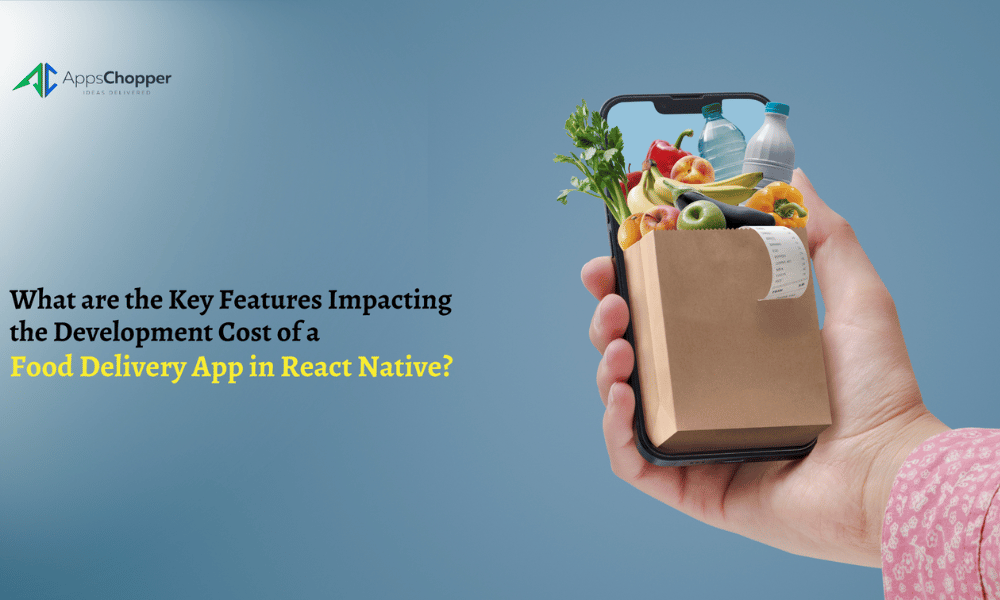Food delivery apps, among the industry restructuring apps, have modernized the customer experience game. Beginning with restaurant review apps like Yelp, the industry has presented customers with convenience. DoorDash, with more than 21 million downloads in 2023, has startled the United States market. Similar is the case with other food delivery apps making it in the saturated market.
Now that food delivery apps like DoorDash are becoming a popular choice among the audience, business owners are making a shift. With the ideas to facilitate the food delivery business, they are building apps with advanced features. For that, some choose native apps like iOS or Android, while others choose React Native app development for both iOS and Android. The difference between the above statement is that few choose between either of the two operating systems, while others build apps on both using cross-platform app development. The reason is that the React Native framework for on demand food delivery app development is cost-effective.
As we stated, it is cost-effective because the developers build one functional code base for both operating systems at the exact cost. The cost goes for the single code base build to function on iOS and Android in the same time as well.
Factors That Affect the Cost to Build a Food Delivery App in React Native
Apprehending the cross-platform functionality must have raised questions about the factors affecting the cost of building a food delivery app. As we move ahead and bring clarity to you about the affecting reason, you must make a decision based on that.
1. Synced Development
Building a food delivery app in React Native brings advantages from a feature worth the capital investment: synchronized development. This enables the food delivery app developers to construct a code once and utilize it across both iOS and Android platforms. Furthermore, as we define, this speeds up the development timeline and presents a cost-efficient option, as updates or transformations can be deployed simultaneously.
Such a futuristic strategy guarantees uniformity in features and design, bypassing the necessity for independent teams or twice the effort for different platforms, ultimately resulting in a more cost-efficient and compatible development process.
2. Singular Team for Cross-Platform Development
As we move ahead, the React Native framework for food delivery apps entitles businesses and chains to utilize a single team for on demand food delivery app development across diverse platforms. The same food delivery app developers tackle Android and iOS versions with a shared codebase, downsizing the necessity for distinct platform iOS and Android specialists.
Such a streamlined React Native approach particularly ameliorates labor costs and coordination time while maintaining consistent quality across platforms. As a positive outcome, companies can establish their food delivery apps faster and more economically without compromising performance or user experience.
3. Utilization of Existing Frameworks
The React Native framework offers food delivery app developers access to multiple existing frameworks, permitting them to utilize pre-built tools to smoothen the development process.
The feature of existing framework utilization recedes time and app development costs, as food delivery app developers can incorporate imperative features such as map navigation, third-party payment gateways, and real-time updates without initiating everything from scratch. By utilizing the power of established frameworks, food delivery businesses can strengthen high-quality performance while upturning the development, thus diminishing the overall cost to build a food delivery app.
4. Reusable Code
One of React Native’s most imperative advantages for on demand food delivery app development is its reusable code, which permits developers to use the same codebase across numerous platforms.
Such a feature drastically diminishes the food delivery app development time and resources demanded for producing and bolstering apps, annihilating the need to create separate iOS and Android code. With reusable components and logic, food delivery businesses save on on-demand app development costs while confirming app consistency, resulting in making this factor of React Native a cost-effective choice for food delivery apps.
5. Low Maintenace Cost
As we know, due to their cross-platform nature, the React Native framework and development for food delivery apps typically have descending maintenance costs. With a shared codebase for iOS and Android, updates in the app, bug fixes, and feature enhancements only must be executed once, profiting both iOS and Android platforms simultaneously.
This low-cost and maintenance approach minimizes abiding development expenditures and diminishes the time mandated for troubleshooting food delivery app-based issues.
Conclusion
As we wind up the feature impacting the food delivery app development cost in the React Native framework, it is clear that it is resourceful for both the food delivery app developers and the businesses. Decision-makers must compare all the frameworks, assess them as per their needs, and then make a wise decision about the usability and feasibility of their app with a food delivery app development company. These companies enable businesses to make better decisions with their valuable insights.




Leave A Comment
You must be logged in to post a comment.